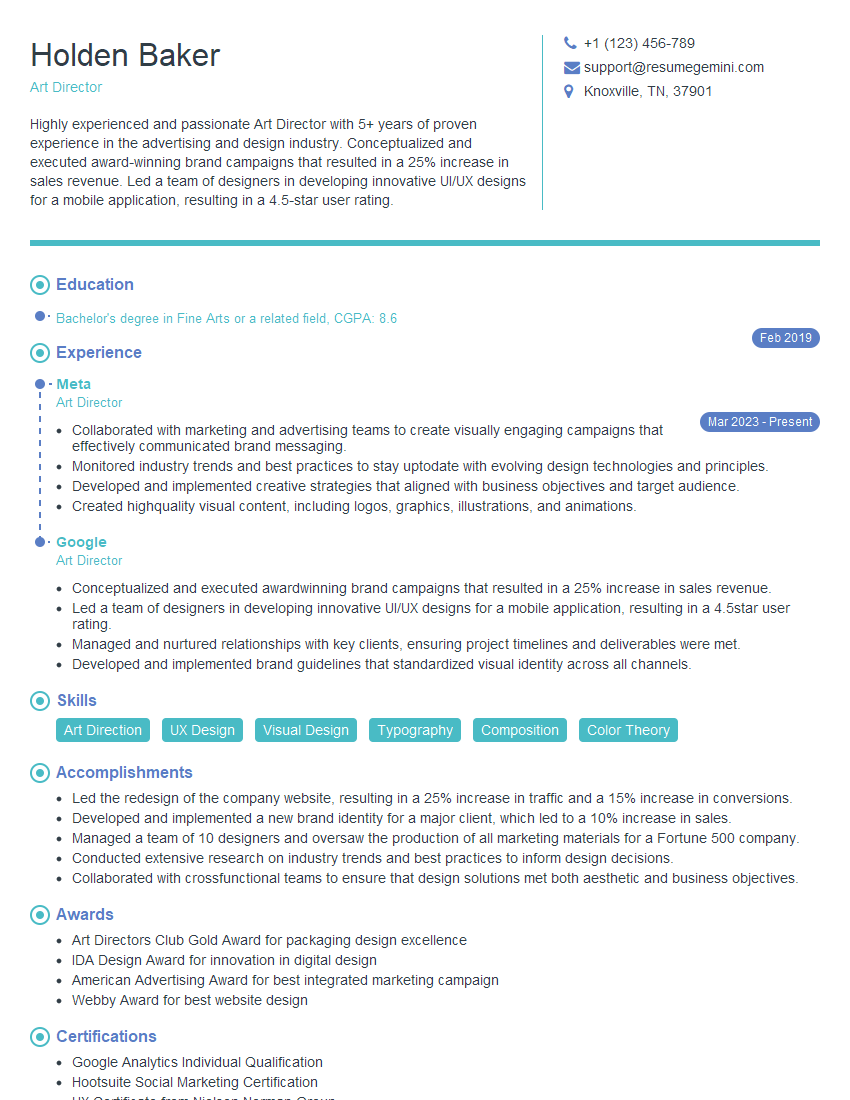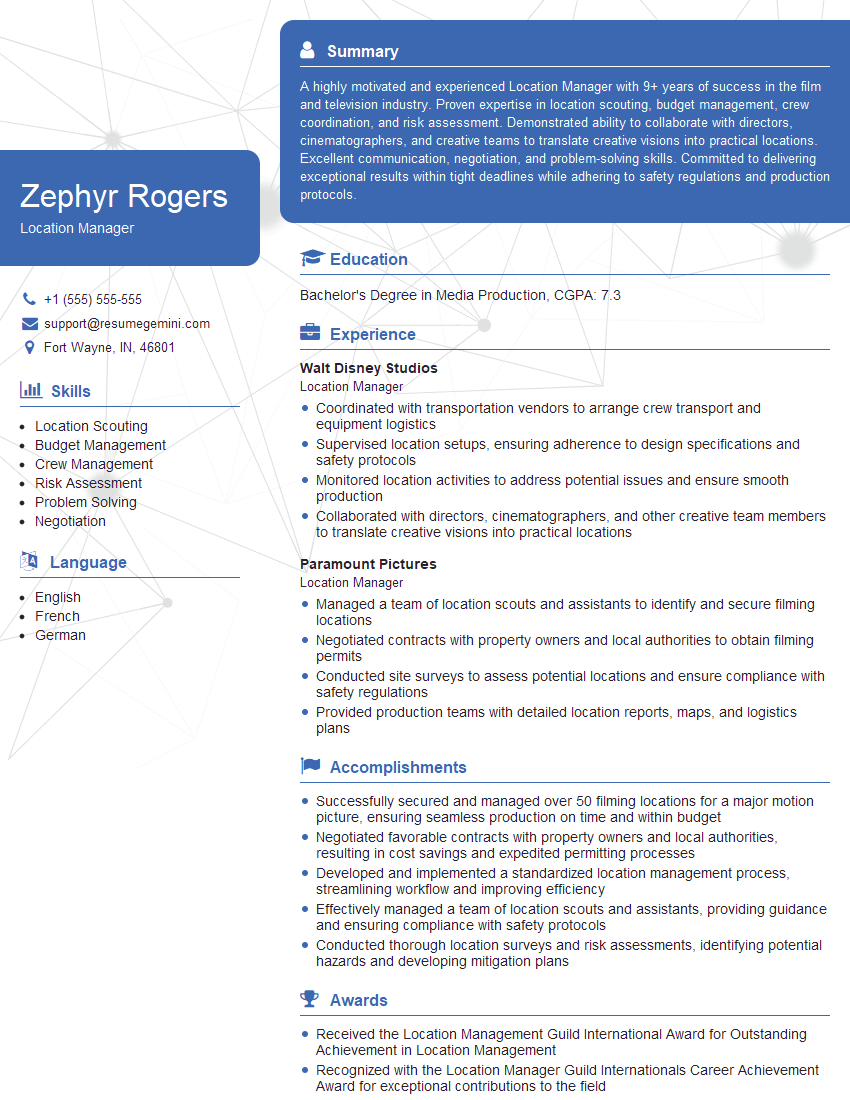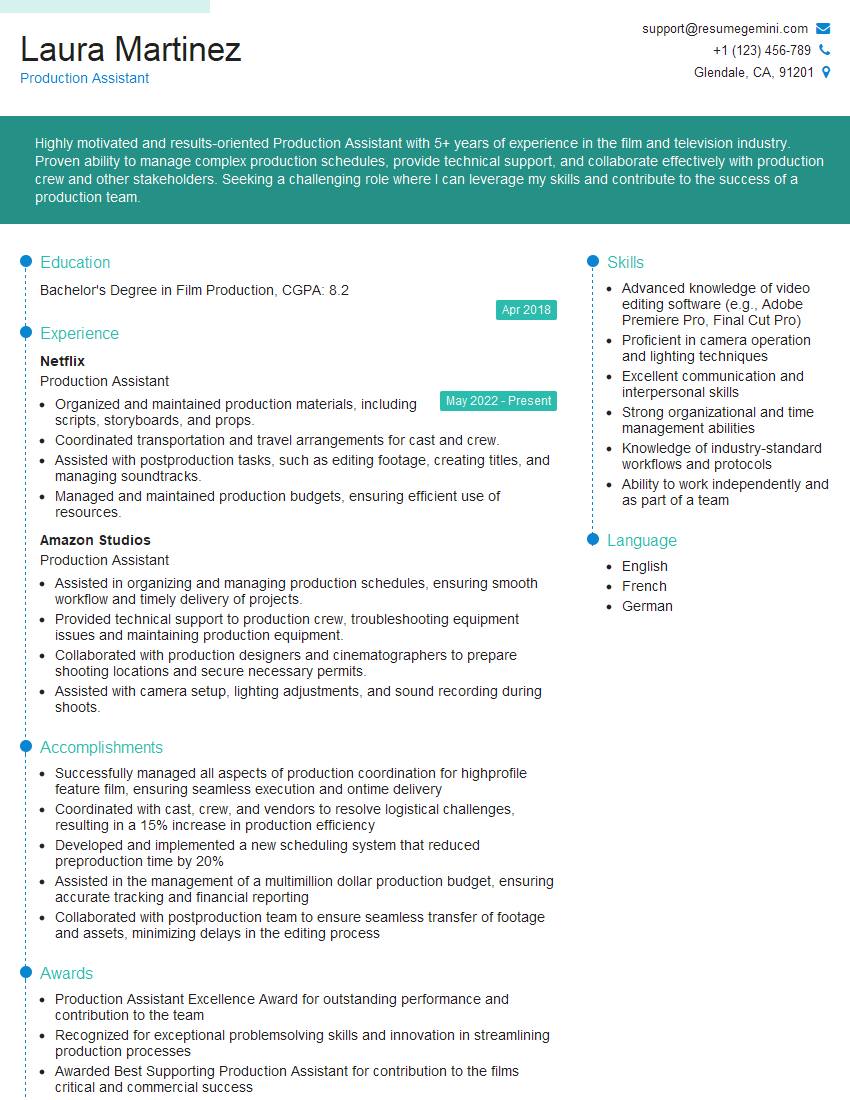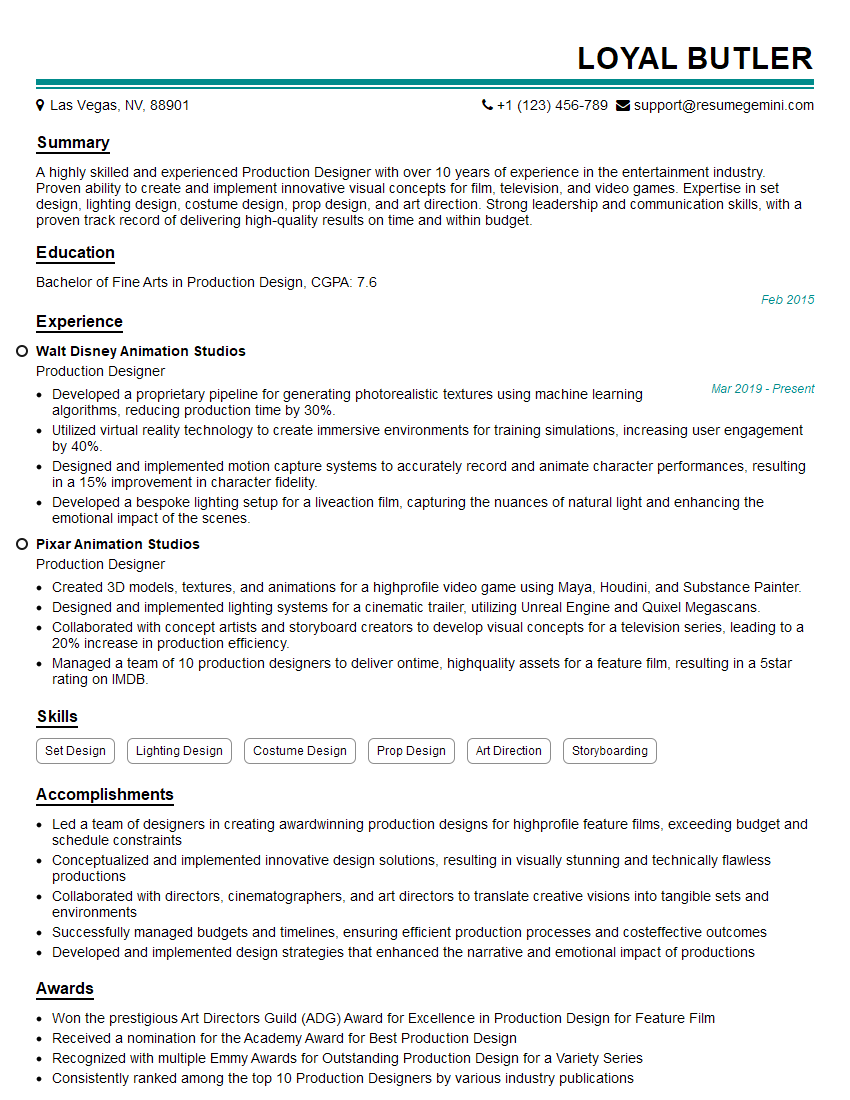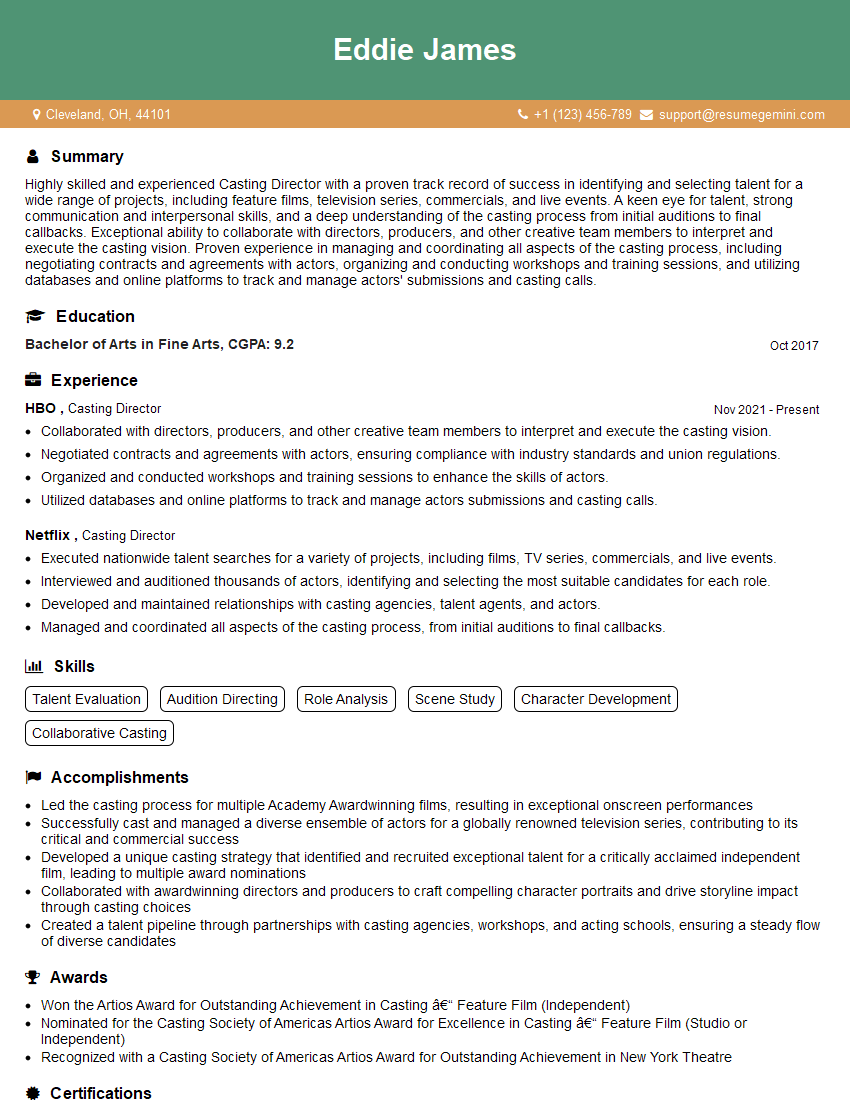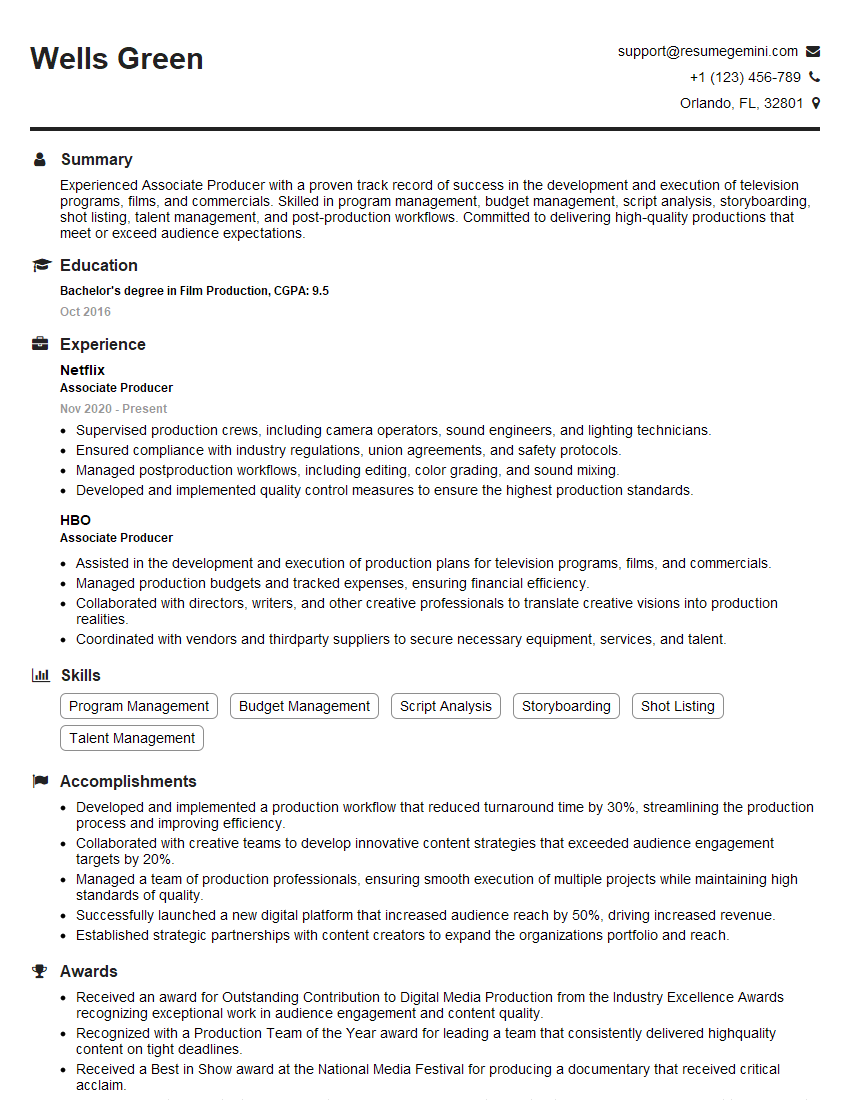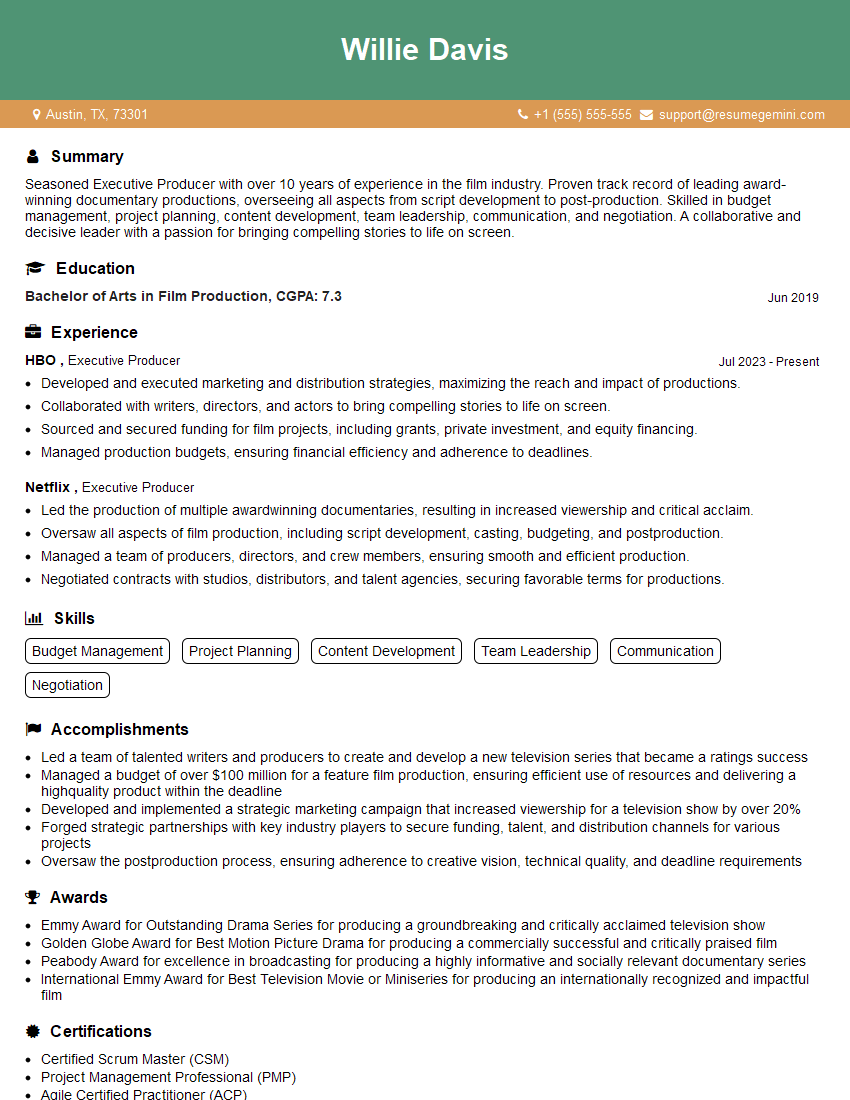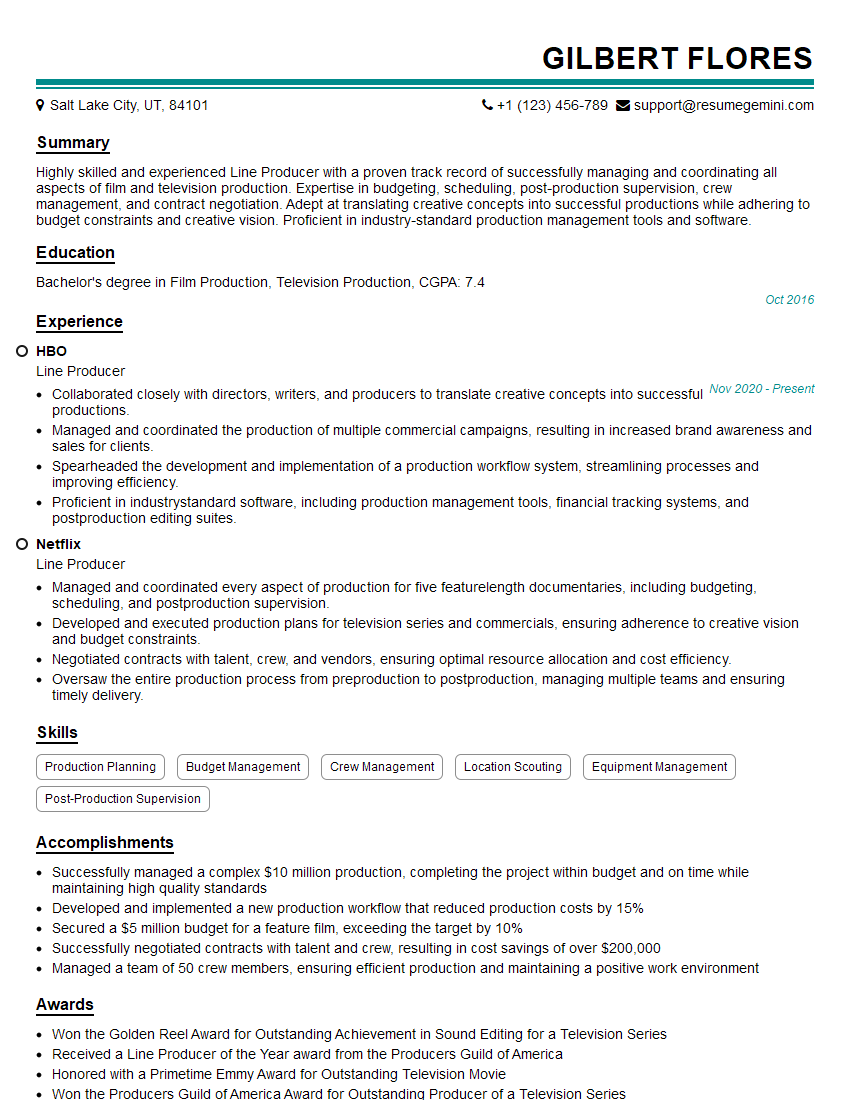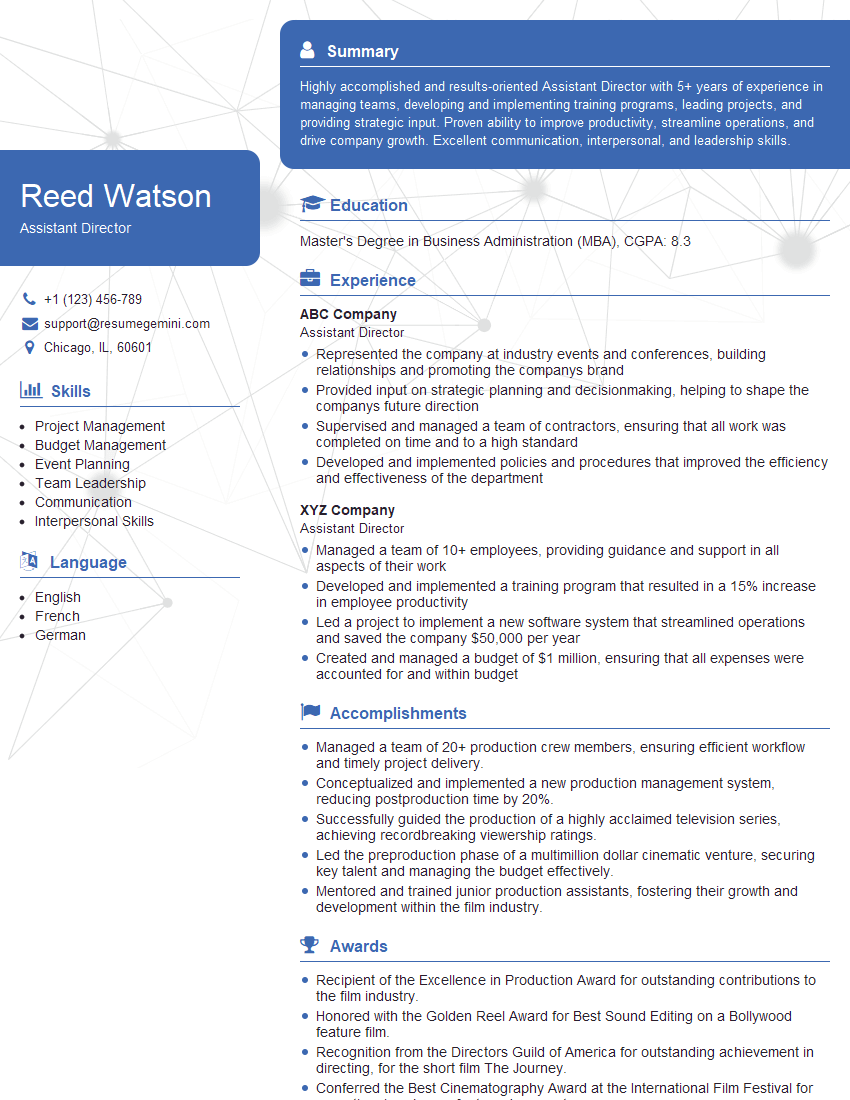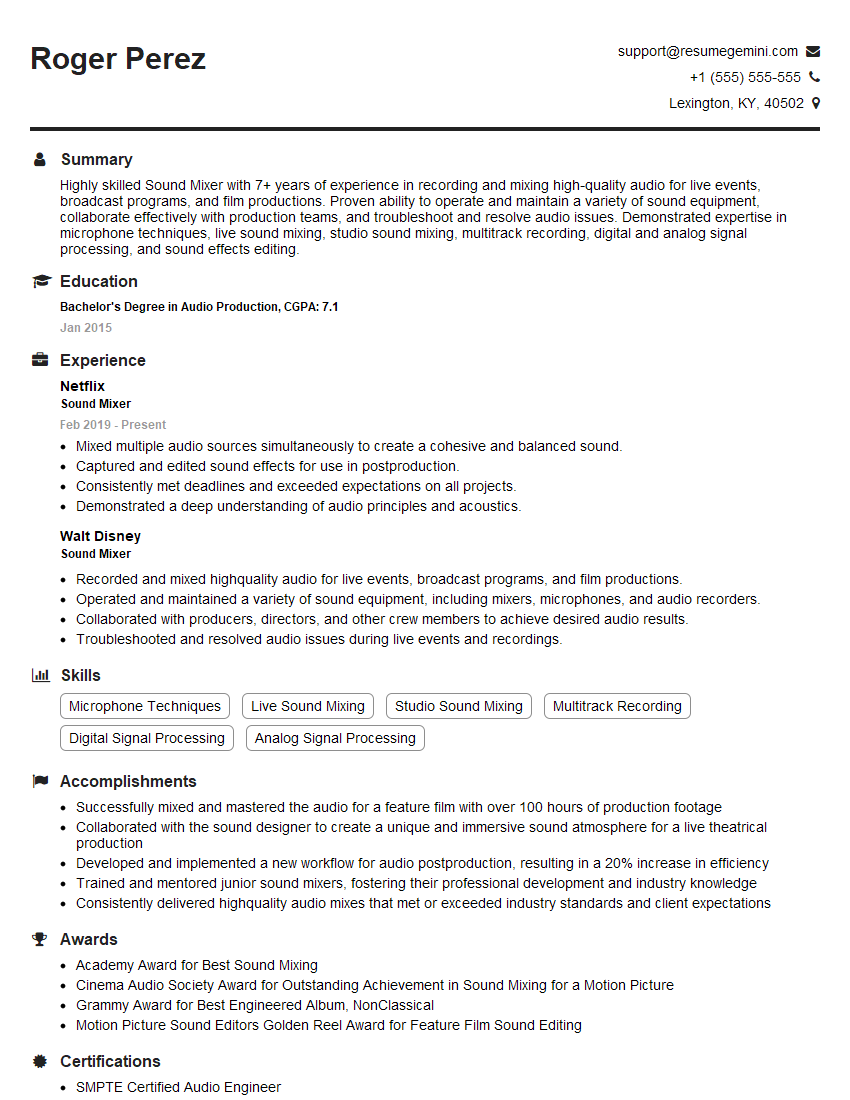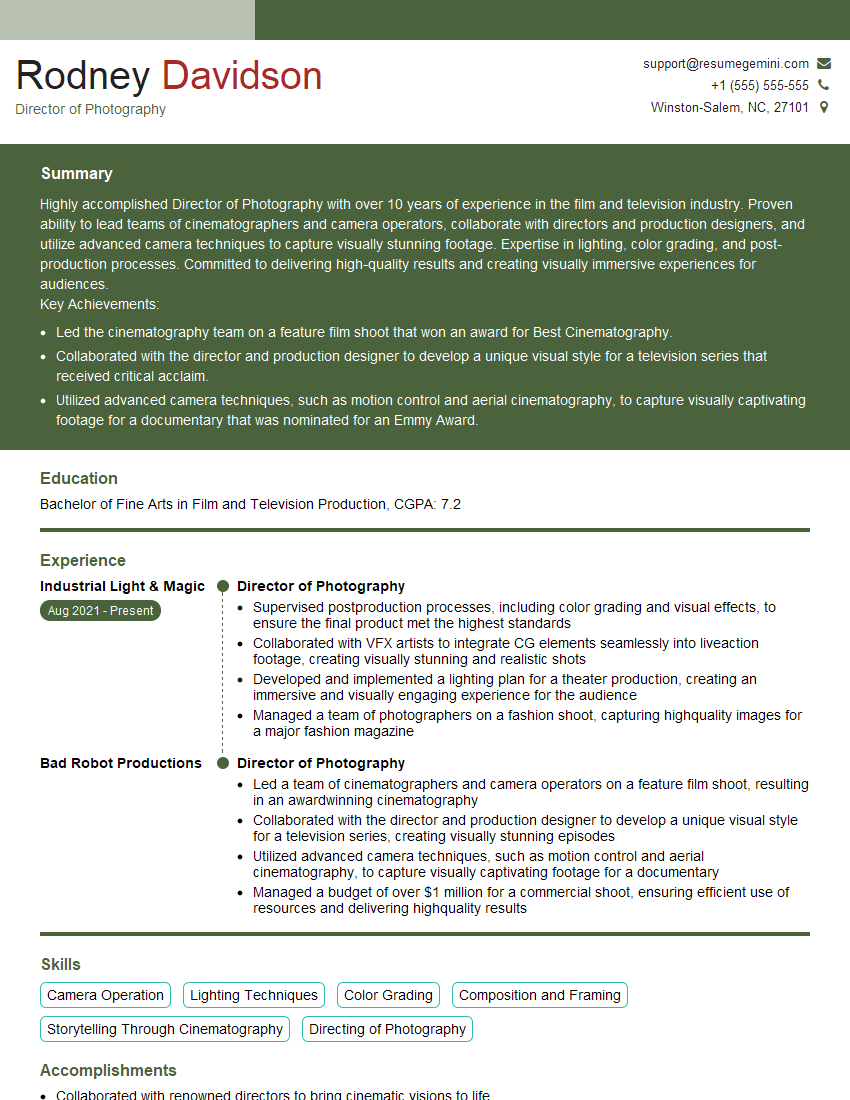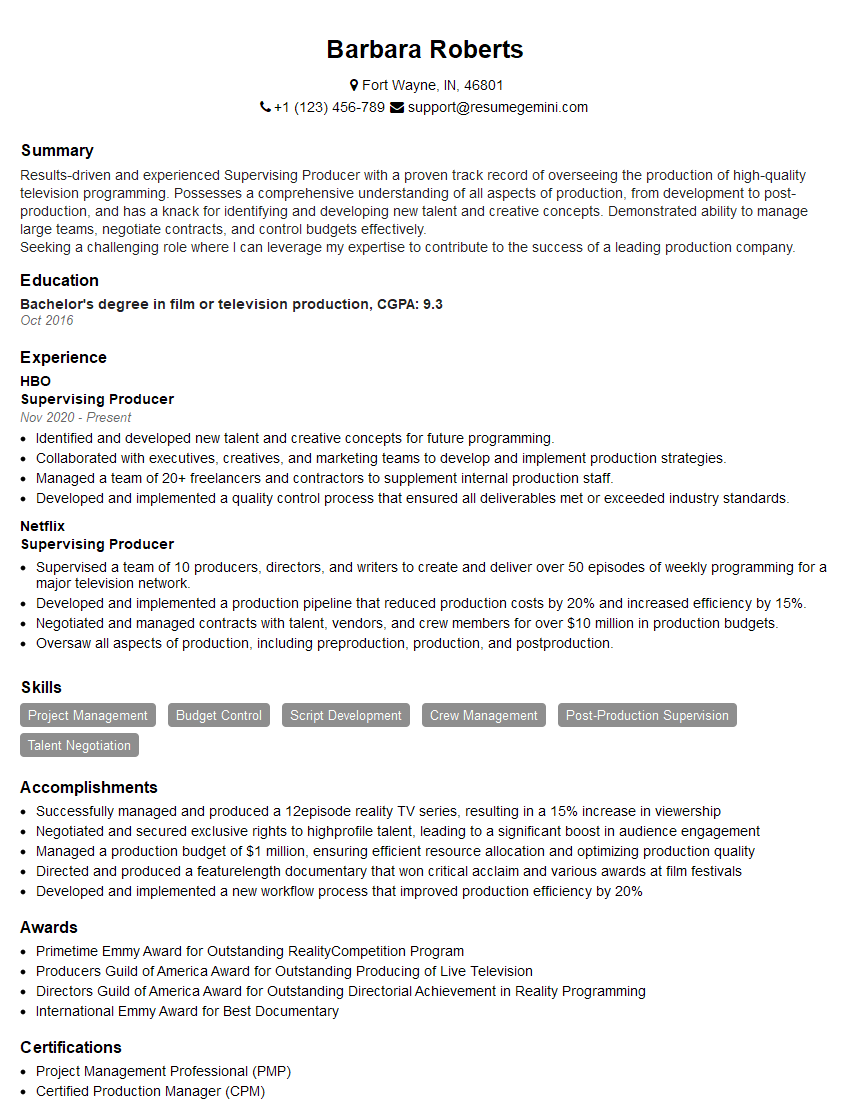The right preparation can turn an interview into an opportunity to showcase your expertise. This guide to Collaborating with Directors and Producers interview questions is your ultimate resource, providing key insights and tips to help you ace your responses and stand out as a top candidate.
Questions Asked in Collaborating with Directors and Producers Interview
Q 1. Describe your experience managing directorial and producer feedback during a project.
Managing directorial and producer feedback requires a delicate balance of active listening, clear communication, and diplomatic negotiation. My approach involves establishing a structured feedback process from the outset. This typically involves regular meetings where both the director and producer can express their notes and concerns. I create a central document – often a shared online spreadsheet or document – to track all feedback, assigning priorities and deadlines for addressing each point.
For example, on a recent independent film project, the director wanted a specific, expensive shot involving a crane. The producer voiced budget concerns. Instead of immediate conflict, we collectively brainstormed alternatives. We explored using a different camera angle, potentially cheaper equipment rentals, or even repositioning existing sets to eliminate the need for the crane entirely. Ultimately, we found a visually satisfying solution that stayed within the budget. The key was open dialogue and a collaborative approach to problem-solving, where everyone felt heard and valued.
Q 2. How do you handle conflicting creative visions between a director and a producer?
Conflicting creative visions between a director and producer are inevitable, but manageable with the right strategies. My approach focuses on identifying the core issues behind the conflict, often going beyond surface-level disagreements. I facilitate discussions that allow both parties to clearly articulate their creative goals, constraints, and concerns. I act as a mediator, helping them find common ground and identify areas of compromise.
Sometimes, this involves reframing the issue. For instance, if a producer’s concern is about marketing appeal, I’ll help the director understand how certain artistic choices might impact audience reception. Conversely, I’ll help the producer appreciate the director’s artistic integrity and how certain creative elements might resonate deeply with the target audience even if they’re unconventional. The goal is not to force a single vision, but to create a shared understanding that respects the individual contributions of both the director and the producer.
Q 3. Explain your process for maintaining effective communication among a production team with diverse perspectives.
Maintaining effective communication in diverse production teams requires a proactive and multifaceted approach. I establish clear communication channels from day one – regular production meetings, dedicated online platforms (Slack, Asana), and individual check-ins. I emphasize the importance of active listening and respectful dialogue, ensuring everyone feels comfortable expressing their thoughts and concerns.
To manage diverse perspectives, I encourage open brainstorming sessions and structured feedback rounds. I also focus on defining roles and responsibilities clearly to avoid overlap and conflict. For instance, clear documentation outlining who is responsible for which aspects of the project prevents confusion and ensures accountability. Finally, regular progress updates ensure that everyone stays informed and engaged, and any potential issues are addressed early on.
Q 4. How would you resolve a scheduling conflict between the director’s vision and the producer’s budget constraints?
Resolving scheduling conflicts requires careful negotiation and prioritization. I begin by analyzing the director’s vision and identifying which elements are essential to the narrative and which are less critical. Simultaneously, I work with the producer to understand the budget constraints and identify areas where costs can be managed effectively.
Often, the solution involves compromise. This might involve simplifying complex scenes, shortening shooting schedules, or identifying less expensive alternatives for certain aspects of the production. Prioritization is key—we establish a hierarchy of scenes and shots based on their contribution to the narrative, allowing us to focus on the essential elements while making compromises on less critical ones. Open communication and a collaborative spirit are critical in finding a mutually acceptable solution.
Q 5. What strategies do you employ to ensure all team members are aligned on project goals and deadlines?
Aligning the team on project goals and deadlines requires a multi-pronged approach. This starts with a clearly defined project brief, setting out the goals, objectives, and timelines. We then break down the project into smaller, manageable tasks, assigning responsibilities and deadlines to each team member. Regular progress meetings and updates are crucial, allowing us to track progress, address any roadblocks, and make necessary adjustments.
I utilize project management tools (e.g., Trello, Asana) to visually track progress and maintain transparency. These tools also facilitate communication and collaboration, ensuring everyone stays informed about their tasks and the overall project status. Regular feedback sessions and open communication channels keep everyone aligned and committed to achieving the common goals within the set timelines.
Q 6. How do you proactively identify potential conflicts between the director’s artistic vision and the producer’s commercial objectives?
Proactive conflict identification involves understanding the underlying goals of both the director and the producer. This requires engaging in open discussions during the pre-production phase to clarify artistic intentions and budget realities. I would facilitate workshops or meetings to explore potential areas of tension. For instance, we might discuss the impact of specific creative choices on marketability or the potential for creative compromises to achieve a more commercially viable product without sacrificing artistic integrity.
Another strategy is reviewing the script and storyboard with both the director and producer to proactively identify potential issues before they escalate into major conflicts. Identifying these points early allows for early intervention and the exploration of alternative approaches, leading to a more streamlined and less stressful production process.
Q 7. Describe a time you had to negotiate a compromise between artistic integrity and budgetary limitations.
On a documentary project, the director envisioned extensive archival footage, which would have significantly increased post-production costs. The producer raised valid concerns about the budget. The director’s artistic integrity was paramount – the archival footage was critical for historical accuracy.
To negotiate a compromise, we carefully reviewed the available archival footage and categorized it based on its importance to the narrative. We prioritized the most essential footage, while exploring less expensive options for supplementing less critical scenes. This included seeking free or low-cost alternatives, negotiating favorable licensing agreements, or even creatively integrating still imagery and narration to replace some of the archival footage. The result was a documentary that maintained its artistic integrity while remaining within budget. This required transparent communication, collaborative problem-solving, and a willingness to compromise on both sides.
Q 8. How do you adapt your communication style to effectively work with different directorial personalities?
Adapting my communication style to different directorial personalities is crucial for effective collaboration. I approach this by first observing and understanding their preferred working methods. Some directors prefer concise, data-driven communication, while others thrive on brainstorming and open dialogue.
For example, with a detail-oriented director, I might prepare comprehensive reports and presentations with meticulous attention to detail. On the other hand, with a more intuitive director, I might focus on visual aids and encourage spontaneous discussions to spark their creativity. The key is flexibility and active listening – tailoring my approach to match their communication preferences, ensuring clear and efficient information exchange. This involves not only verbal communication but also understanding their preferred mediums for feedback and updates (email, instant messaging, in-person meetings, etc.).
Q 9. Explain your experience in facilitating creative brainstorming sessions with directors and producers.
Facilitating creative brainstorming sessions requires a structured yet flexible approach. I begin by setting a clear objective and agenda, ensuring everyone understands the goals of the session. I then use a variety of techniques to encourage participation and idea generation. These include mind mapping, SWOT analysis, and ‘round robin’ discussions where each participant contributes an idea.
In one project, we utilized a visual brainstorming technique where team members contributed ideas to a large whiteboard, encouraging free-flowing creativity and visual representation of the ideas. The session was recorded and all the ideas were systematically documented and later evaluated for feasibility and alignment with the project goals. It’s essential to create a safe and inclusive environment where everyone feels comfortable sharing their thoughts, regardless of their role or seniority. Following the session, I consolidate and document all generated ideas for future reference and decision-making.
Q 10. How do you track and manage the progress of a project to meet both artistic and production deadlines?
Tracking and managing project progress requires a multifaceted approach that balances artistic vision and production realities. I use project management software to create detailed schedules, assigning tasks and deadlines, and tracking progress visually using Gantt charts or Kanban boards. Regular progress meetings, involving directors, producers, and key team members, are vital. These meetings aren’t just about checking off tasks but reviewing artistic decisions and addressing potential roadblocks proactively.
For instance, in a recent film production, we used a cloud-based project management tool that allowed everyone to access real-time updates and share documents. We held weekly status meetings to review the shooting schedule, address any creative challenges, and ensure we remained on budget and on schedule. Furthermore, using a risk assessment framework helped identify and mitigate potential delays before they became critical issues, ensuring both artistic excellence and timely completion.
Q 11. How have you used data or analytics to inform decisions in collaboration with directors and producers?
Data and analytics play a crucial role in informing collaborative decisions. Audience research, for example, can inform casting decisions, marketing strategies, and even creative choices. Analyzing audience demographics, viewing habits, and social media engagement can help tailor the project to resonate with its target audience.
In a recent documentary project, we analyzed audience feedback from early screenings to adjust the narrative structure and pacing before the final cut. This data-driven approach allowed us to make informed adjustments that ultimately enhanced the audience experience. We also used analytics to optimize our marketing campaign, targeting specific demographics with tailored messages and improving the film’s reach and impact. This data-informed approach demonstrates a commitment to evidence-based decision-making.
Q 12. What methods do you use to document and share decisions made collaboratively with directors and producers?
Documenting and sharing collaborative decisions is paramount for transparency and accountability. I use a combination of methods to ensure a clear record of all decisions. Meeting minutes, which meticulously document decisions, action items, and assigned responsibilities, are essential.
We also utilize shared online document repositories where all key decisions and creative choices are stored for easy access. This system ensures that everyone involved has access to the most updated information, minimizing confusion and misunderstandings. Using version control software for scripts and other creative assets further ensures that the final product reflects the agreed-upon decisions.
Q 13. How do you handle feedback that challenges your own ideas or suggestions?
Handling feedback that challenges my ideas requires a professional and receptive approach. I view feedback as an opportunity for growth and improvement, regardless of whether it aligns with my initial suggestions. I listen attentively, ask clarifying questions to fully understand the concerns, and then respond thoughtfully and respectfully.
It’s crucial to maintain a collaborative spirit, acknowledging the validity of differing perspectives. I might explain my rationale behind the original idea, but ultimately, the goal is to find a solution that satisfies both the artistic vision and the practical needs of the project. Compromise and a willingness to adapt are key to navigating these situations effectively.
Q 14. Describe your experience building consensus among team members with varying opinions.
Building consensus amongst team members with differing opinions necessitates open communication, active listening, and a commitment to finding common ground. I facilitate discussions that allow everyone to express their viewpoints fully and respectfully.
One effective technique I use is to identify common goals and shared values. By focusing on the overarching objectives of the project, it’s often easier to find compromises that accommodate varied perspectives. I also actively seek solutions that incorporate elements from different ideas, creating a sense of ownership and buy-in among all participants. In essence, the process centers on fostering a collaborative environment that values the diversity of opinions and ultimately contributes to a better outcome.
Q 15. How do you maintain positive working relationships when facing challenging production issues?
Maintaining positive working relationships during challenging production issues requires proactive communication, empathy, and a problem-solving approach. Think of it like navigating a storm – you need a strong ship (your team) and a clear map (your plan).
- Open Communication: Regular, transparent communication is key. Holding daily or weekly production meetings, where everyone can voice concerns and offer solutions, prevents small problems from escalating into major conflicts.
- Empathy and Understanding: Recognize that everyone is under pressure. Listen actively to concerns, validate feelings, and show understanding. Remember that delays and setbacks affect everyone differently.
- Collaborative Problem-Solving: Instead of assigning blame, focus on finding solutions together. Brainstorm ideas, leverage each team member’s expertise, and create a shared action plan. The goal is to move forward, not to dwell on what went wrong.
- Conflict Resolution: If disagreements arise, address them directly and respectfully. Use a collaborative approach, such as mediation, to find mutually agreeable solutions.
For example, during a shoot where weather caused unexpected delays, we held an open meeting to assess the situation. Instead of blaming the weather, we brainstormed alternative shooting locations and adjusted the schedule accordingly. This collaborative approach prevented frustration and maintained team morale.
Career Expert Tips:
- Ace those interviews! Prepare effectively by reviewing the Top 50 Most Common Interview Questions on ResumeGemini.
- Navigate your job search with confidence! Explore a wide range of Career Tips on ResumeGemini. Learn about common challenges and recommendations to overcome them.
- Craft the perfect resume! Master the Art of Resume Writing with ResumeGemini’s guide. Showcase your unique qualifications and achievements effectively.
- Don’t miss out on holiday savings! Build your dream resume with ResumeGemini’s ATS optimized templates.
Q 16. How do you balance the director’s creative vision with the producer’s business objectives?
Balancing the director’s creative vision with the producer’s business objectives is a delicate but essential skill in filmmaking. It’s like finding the perfect harmony between art and commerce.
- Early Collaboration: Involve both the director and producer early in the pre-production phase. This allows for open dialogue about creative choices and their budgetary implications, setting realistic expectations from the start.
- Compromise and Negotiation: Often, creative choices have financial consequences. This requires negotiation and compromise. The producer might suggest cost-effective alternatives that still maintain the creative integrity of the project. The director might need to adjust the scope of a particular scene or sequence to stay within budget.
- Prioritization: Prioritize key scenes or sequences that are essential to the overall story and allocate resources accordingly. This may involve scaling back on less critical elements.
- Data-Driven Decision Making: Use data like audience research or test screenings to inform decisions, demonstrating the potential return on investment for certain creative choices.
For instance, on a previous project, the director envisioned a complex CGI sequence. The producer, while acknowledging the creative value, presented data showing the high cost. We collaborated to find a simpler, equally effective solution that achieved the director’s vision without overspending.
Q 17. Describe a situation where you had to advocate for a creative decision against a producer’s initial reservations.
During a documentary, the director wanted to include a controversial interview segment that challenged the narrative somewhat but added a crucial layer of authenticity. The producer initially expressed reservations due to potential backlash and the risk of upsetting sponsors.
My approach involved:
- Presenting Data: I presented audience research suggesting that a more nuanced narrative would resonate better with the target audience, potentially increasing viewership.
- Risk Mitigation: I proposed strategies to mitigate the risks, such as careful editing and contextualization of the interview segment, and an alternative ending that could be used depending on response.
- Highlighting the Artistic Merit: I emphasized the segment’s artistic value and its contribution to the overall integrity of the film.
- Open Discussion: I facilitated an open discussion between the director and producer, creating a safe space for expressing concerns and finding common ground.
Ultimately, the producer agreed to include the segment, recognizing its potential to generate greater impact and critical acclaim. This outcome showed the power of carefully articulating the creative vision and addressing concerns proactively.
Q 18. How do you ensure all creative team members feel valued and heard during the collaboration process?
Making sure every creative team member feels valued involves fostering a culture of respect, open communication, and inclusion. This is crucial for building a collaborative and productive environment.
- Regular Feedback Sessions: Conduct regular one-on-one meetings with each team member to solicit feedback, address concerns, and offer support.
- Open Communication Channels: Establish clear and accessible communication channels. This could be through daily stand-up meetings, email threads, or a dedicated project management platform.
- Collaborative Decision-Making: Involve team members in creative decision-making processes whenever possible, giving them a voice in shaping the project.
- Recognition and Appreciation: Publicly acknowledge and appreciate individual contributions and achievements. This can boost morale and foster a sense of belonging.
- Mentorship and Support: Offer mentorship opportunities and provide support to junior team members, fostering their growth and development.
For example, I implemented a system of weekly feedback sessions on our last project. This allowed team members to express their concerns and ideas directly. This approach led to more innovative solutions and increased team satisfaction.
Q 19. How do you ensure all communication is effectively documented and archived?
Effective documentation and archiving of communication are vital for transparency, accountability, and future reference. Think of it like keeping a meticulous record of a building project: you need to know what has been done, who did it, and when it was done.
- Centralized Communication Platform: Use a central platform for all project communication. This might be a project management tool (e.g., Asana, Trello, Monday.com) or a shared drive with clearly organized folders.
- Meeting Minutes: Keep detailed minutes of all meetings, including decisions made, action items, and assigned responsibilities.
- Version Control: Use version control for creative assets (e.g., scripts, storyboards, designs) to track changes and revert to previous versions if necessary.
- Email Archiving: Archive all relevant emails in a structured manner, using descriptive subject lines and folders.
- Regular Backups: Ensure regular backups of all project files and communication records to protect against data loss.
For instance, on a recent film production, we utilized a cloud-based project management tool to maintain a centralized repository for all communication and project files. This ensured that all team members had access to up-to-date information and allowed for seamless collaboration.
Q 20. What software or tools do you use to facilitate collaboration and communication amongst the team?
Many software and tools facilitate collaboration and communication, choosing the right ones depends on the project’s needs and team size.
- Project Management Tools: Asana, Trello, Monday.com, Jira are used for task assignment, progress tracking, and communication.
Example: Asana can be used to assign tasks to individuals, track deadlines, and maintain a shared calendar. - Video Conferencing: Zoom, Google Meet, Skype, for remote collaboration and meetings.
- Cloud Storage: Google Drive, Dropbox, Box, for sharing files and documents.
- Communication Platforms: Slack, Microsoft Teams, for instant messaging and group communication.
- Version Control Systems: Git (GitHub, GitLab, Bitbucket) for managing code and other creative assets.
The choice depends on team preference and budget. Smaller projects might use a simpler tool like Google Drive and Slack, while larger projects with diverse teams might employ a more comprehensive platform like Asana alongside other tools.
Q 21. How would you handle a situation where a director changes their vision mid-production?
A director changing their vision mid-production is a challenging but not insurmountable situation. It requires a calm, collaborative approach, focused on understanding the reasons behind the change and finding solutions.
- Understand the Rationale: The first step is to understand why the director wants to change their vision. Are there new insights from research, feedback, or an evolution of their artistic intent?
- Assess the Impact: Determine the impact of the change on the schedule, budget, and overall project goals. Will it require reshoots, additional resources, or a revised timeline?
- Communicate Clearly: Communicate the change to the team clearly and transparently, outlining the rationale and the impact. Be prepared to address potential concerns.
- Collaborative Problem-Solving: Work with the director, producer, and the team to find solutions that accommodate the revised vision without compromising the project’s success. This might involve revising the budget, adjusting the shooting schedule, or finding creative compromises.
- Document the Changes: Thoroughly document all changes to the script, storyboard, shooting schedule, and budget, keeping a record of approvals and decisions.
In one instance, a director decided to shift a scene’s setting mid-production. We immediately assessed the impact, communicated with the team, and found an alternative location that was cost-effective and maintained the director’s artistic vision. While it created minor delays, open communication ensured a smooth adjustment, and the change actually enhanced the film’s impact.
Q 22. Describe your approach to conflict resolution in a fast-paced production environment.
Conflict resolution in a fast-paced production environment requires a proactive and collaborative approach. My strategy focuses on early identification, open communication, and finding mutually beneficial solutions. I believe in addressing issues directly but respectfully, aiming for a swift resolution without compromising creative vision or team morale.
My approach involves these steps:
- Identify the root cause: Instead of focusing on symptoms, I delve into the underlying reasons for the conflict. Is it a miscommunication, a clash of personalities, a scheduling issue, or resource constraints?
- Active listening and empathy: I actively listen to all parties involved, seeking to understand their perspectives and concerns. Empathy is crucial in building trust and fostering collaboration.
- Collaborative problem-solving: I facilitate a discussion where all parties are encouraged to brainstorm solutions. The goal isn’t to find a ‘winner’ but a solution that works for everyone involved, even if it’s a compromise.
- Documenting agreements: Once a solution is reached, I ensure it’s documented clearly and shared with all parties involved. This helps avoid future misunderstandings and ensures accountability.
- Follow-up: I follow up to ensure the agreed-upon solution is implemented effectively and to address any lingering concerns.
For example, I once had a conflict between the director and the cinematographer regarding lighting choices. By facilitating a discussion where both parties explained their artistic vision and concerns, we found a compromise that satisfied both creative needs and kept the production on schedule.
Q 23. How do you build trust and rapport with directors and producers?
Building trust and rapport with directors and producers is paramount. It’s built on a foundation of professionalism, reliability, and clear communication. I strive to become a valuable partner, not just an employee.
- Proactive communication: I keep them consistently updated on progress, challenges, and potential solutions, proactively addressing any concerns before they escalate.
- Demonstrate competence: I showcase my skills and expertise through efficient task management, meticulous planning, and proactive problem-solving. Results speak louder than words.
- Understanding their vision: I take the time to fully understand their artistic vision, making sure I’m aligned with their goals and objectives. This demonstrates respect and commitment.
- Respectful collaboration: I value their input and expertise, collaborating closely with them on creative decisions and ensuring they are fully involved throughout the process.
- Being responsive and reliable: I respond promptly to emails and inquiries, meet deadlines, and handle unforeseen circumstances with grace and efficiency.
In one project, I built strong rapport with the director by proactively suggesting solutions to complex logistical challenges, thus saving time and money. This demonstrated my value and strengthened our working relationship.
Q 24. Describe your experience managing expectations with directors and producers regarding project scope and timelines.
Managing expectations regarding project scope and timelines is critical for successful collaboration. It requires clear communication, realistic planning, and a willingness to adapt to changing circumstances.
- Detailed pre-production planning: I meticulously plan every stage of the project, breaking down tasks into manageable units and establishing clear timelines. This allows for transparent progress tracking.
- Regular progress reports: I provide regular updates to the director and producer, highlighting accomplishments, potential roadblocks, and necessary adjustments. This keeps everyone informed and allows for early intervention.
- Open communication about challenges: I openly communicate any unforeseen challenges or potential delays, proposing solutions and adjustments proactively rather than waiting for issues to escalate.
- Contingency planning: I develop contingency plans to address potential setbacks and ensure the project stays on track, even amidst unexpected circumstances.
- Collaborative scope management: I work closely with the director and producer to define a realistic project scope, ensuring that everyone is on the same page and expectations are clearly outlined.
For example, on a documentary film, we encountered unexpected delays due to access issues. By communicating the situation openly and proposing alternative solutions, we managed to keep the production on schedule, albeit with minor adjustments to the timeline.
Q 25. How do you handle criticism from directors or producers constructively?
Handling criticism constructively requires a professional and receptive attitude. My approach focuses on understanding the feedback, learning from it, and implementing necessary improvements.
- Active listening: I listen attentively to the criticism without interrupting, ensuring I fully understand the director or producer’s concerns.
- Seeking clarification: If anything is unclear, I ask clarifying questions to ensure I fully grasp the feedback.
- Acknowledging the feedback: I acknowledge the feedback, even if I don’t agree with it entirely. This shows respect and a willingness to engage.
- Analyzing the feedback: I analyze the feedback objectively, determining its validity and relevance to the project.
- Implementing improvements: I implement the necessary changes or improvements based on the feedback, demonstrating my commitment to excellence.
I once received criticism for a specific scene’s pacing. By carefully analyzing the feedback, I realized the pacing issue was valid. I then made adjustments to the editing, resulting in a significantly improved scene that aligned better with the director’s vision.
Q 26. How would you handle a disagreement with a director or producer regarding a creative decision?
Disagreements regarding creative decisions are inevitable. My approach emphasizes collaborative problem-solving and respect for differing artistic perspectives.
- Understanding perspectives: I actively listen to both sides, trying to understand the rationale behind each viewpoint.
- Data-driven discussion: If possible, I use data or relevant examples to support different approaches.
- Finding common ground: I work to find common ground, exploring alternative options that accommodate both perspectives.
- Compromise and collaboration: I encourage compromise and collaboration, aiming for a solution that satisfies both creative visions while maintaining the overall project goals.
- Respectful disagreement: I maintain a respectful and professional demeanor, even if I strongly disagree with a particular decision.
In one project, the director and producer had differing opinions regarding the ending of the film. By facilitating a discussion and exploring various alternatives, we arrived at a compromise that incorporated elements from both suggestions, resulting in a more impactful and satisfying conclusion.
Q 27. How do you prioritize tasks effectively to ensure successful collaboration between the director and the producer?
Prioritizing tasks effectively is crucial for successful director-producer collaboration. I utilize a combination of strategies to streamline the process and ensure efficient workflow.
- Collaborative task management: I use project management tools (more on this in the next answer) to create a shared task list that outlines responsibilities, deadlines, and dependencies. This ensures transparency and accountability.
- Prioritization based on deadlines and dependencies: I prioritize tasks based on their deadlines and dependencies, ensuring critical tasks are completed first.
- Regular progress tracking: I monitor progress regularly, identifying any potential delays or bottlenecks early on.
- Flexible adaptation: I adapt the priority list as needed based on changing circumstances and new information.
- Clear communication of priorities: I clearly communicate the prioritized task list to the director and producer, ensuring everyone is aligned on the project’s trajectory.
For example, in a recent project, we prioritized the completion of key scenes with the lead actor, as they had a limited availability window. This ensured smooth production and avoided potential scheduling conflicts.
Q 28. Describe your experience using project management software to improve director and producer collaboration.
Project management software significantly improves director and producer collaboration. I have extensive experience using various platforms, including Asana, Trello, and Monday.com. These tools facilitate communication, task management, and progress tracking, improving overall efficiency and transparency.
- Centralized communication: The software provides a central hub for communication, eliminating the need for numerous emails and facilitating quick updates and discussions.
- Shared task lists and calendars: The shared task lists and calendars ensure everyone is aware of deadlines and responsibilities, preventing misunderstandings and scheduling conflicts.
- Progress tracking and reporting: The progress tracking features provide clear visibility into the project’s status, allowing for timely interventions if necessary.
- File sharing and collaboration: File sharing capabilities allow for easy access to documents, scripts, and other relevant materials.
- Version control: Version control features ensure that everyone is working with the most up-to-date version of documents.
For instance, using Asana, I created a project board with task assignments, deadlines, and progress updates, visible to both the director and producer. This fostered greater transparency and collaboration, allowing for quick issue resolution and a streamlined workflow.
Key Topics to Learn for Collaborating with Directors and Producers Interview
- Understanding Creative Vision: Learn to effectively interpret and articulate the director’s and producer’s creative vision, ensuring a shared understanding of the project’s goals and objectives. This includes actively listening, asking clarifying questions, and offering constructive feedback.
- Effective Communication & Collaboration: Practice clear, concise, and professional communication strategies. This involves mastering both verbal and written communication, adapting your approach to different personalities and communication styles. Consider how to manage conflicting opinions constructively and collaboratively.
- Problem-Solving & Resource Management: Develop strategies for proactively identifying and resolving potential challenges during production. This includes understanding budgeting constraints, scheduling complexities, and navigating creative differences. Demonstrate your ability to think on your feet and offer practical solutions.
- Negotiation & Conflict Resolution: Explore effective negotiation techniques to balance creative vision with practical limitations. Practice resolving conflicts diplomatically and professionally, maintaining positive working relationships throughout the production process.
- Project Management Fundamentals: Familiarize yourself with basic project management principles, such as task delegation, timeline management, and progress tracking. Show how you can contribute to a smoothly running production.
- Adaptability & Flexibility: The entertainment industry is dynamic. Showcase your ability to adapt to changing circumstances, unexpected challenges, and evolving creative directions. Highlight instances where you remained calm and effective under pressure.
Next Steps
Mastering collaboration with directors and producers is crucial for career advancement in the entertainment industry. It demonstrates essential soft skills and a deep understanding of the collaborative nature of filmmaking and production. To significantly boost your job prospects, creating an ATS-friendly resume is vital. ResumeGemini can be a trusted partner in this process, helping you craft a compelling and effective resume that highlights your relevant experience and skills. Examples of resumes tailored to showcasing experience in collaborating with directors and producers are available within ResumeGemini to help you build your own.
Explore more articles
Users Rating of Our Blogs
Share Your Experience
We value your feedback! Please rate our content and share your thoughts (optional).
What Readers Say About Our Blog
Hi, I represent an SEO company that specialises in getting you AI citations and higher rankings on Google. I’d like to offer you a 100% free SEO audit for your website. Would you be interested?
Dear Sir/Madam,
Do you want to become a vendor/supplier/service provider of Delta Air Lines, Inc.? We are looking for a reliable, innovative and fair partner for 2025/2026 series tender projects, tasks and contracts. Kindly indicate your interest by requesting a pre-qualification questionnaire. With this information, we will analyze whether you meet the minimum requirements to collaborate with us.
Best regards,
Carey Richardson
V.P. – Corporate Audit and Enterprise Risk Management
Delta Air Lines Inc
Group Procurement & Contracts Center
1030 Delta Boulevard,
Atlanta, GA 30354-1989
United States
+1(470) 982-2456

